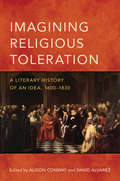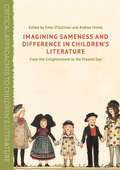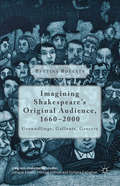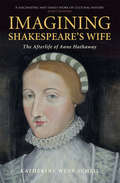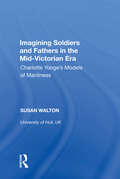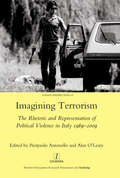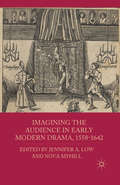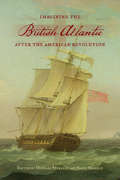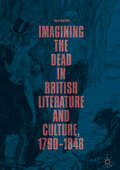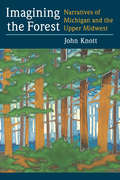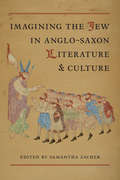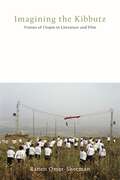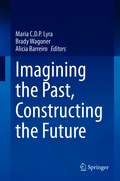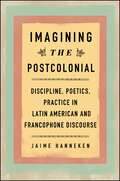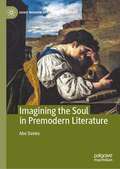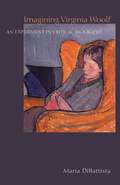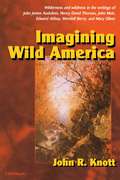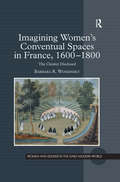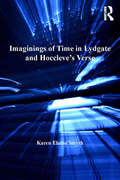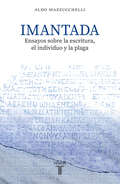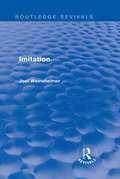- Table View
- List View
Imagining Religious Toleration: A Literary History of an Idea, 1600–1830
by Alison Conway David AlvarezFormerly a site of study reserved for intellectual historians and political philosophers, scholarship on religious toleration, from the perspective of literary scholars, is fairly limited. Largely ignored and understudied techniques employed by writers to influence cultural understandings of tolerance are rich for exploration. In investigating the eighteenth-century novel, Alison Conway, David Alvarez, and their contributors shed light on what literature can say about toleration, and how it can produce and manage feelings of tolerance and intolerance. Beginning with an overview of the historical debates surrounding the terms "toleration" and "tolerance," this book moves on to discuss the specific contributions that literature and literary modes have made to cultural history, studying the literary techniques that philosophers, theologians, and political theorists used to frame the questions central to the idea and practice of religious toleration. Tracing the rhetoric employed by a wide range of authors, the contributors delve into topics such as conversion as an instrument of power in Shakespeare; the relationship between religious toleration and the rise of Enlightenment satire; and the ways in which writing can act as a call for tolerance.
Imagining Sameness and Difference in Children's Literature
by Emer O’sullivan Andrea ImmelThis book investigates how cultural sameness and difference has been presented in a variety of forms and genres of children's literature from Denmark, Germany, France, Russia, Britain, and the United States; ranging from English caricatures of the 1780s to dynamic representations of contemporary cosmopolitan childhood. The chapters address different models of presenting foreigners using examples from children's educational prints, dramatic performances, travel narratives, comics, and picture books. Contributors illuminate the ways in which the texts negotiate the tensions between the Enlightenment ideal of internationalism and discrete national or ethnic identities cultivated since the Romantic era, providing examples of ethnocentric cultural perspectives and of cultural relativism, as well as instances where discussions of child reader agency indicate how they might participate eventually in a tolerant transnational community.
Imagining Shakespeare's Original Audience, 1660-2000: Groundlings, Gallants, Grocers (Palgrave Shakespeare Studies)
by Bettina BoeckerComparatively little is known about Shakespeare's first audiences. This study argues that the Elizabethan audience is an essential part of Shakespeare as a site of cultural meaning, and that the way criticism thinks of early modern theatregoers is directly related to the way it thinks of, and uses, the Bard himself.
Imagining Shakespeare's Wife: The Afterlife of Anne Hathaway
by Katherine West ScheilWhat has been the appeal of Anne Hathaway, both globally and temporally, over the past four hundred years? Why does she continue to be reinterpreted and reshaped? Imagining Shakespeare's Wife examines representations of Hathaway, from the earliest depictions and details in the eighteenth century, to contemporary portrayals in theatre, biographies and novels. Residing in the nexus between Shakespeare's life and works, Hathaway has been constructed to explain the women in the plays but also composed from the material in the plays. Presenting the very first cultural history of Hathaway, Katherine Scheil offers a richly original study that uncovers how the material circumstances of history affect the later reconstruction of lives.
Imagining Soldiers and Fathers in the Mid-Victorian Era: Charlotte Yonge's Models of Manliness
by Susan WaltonBeginning with the premise that women's perceptions of manliness are crucial to its construction, The author focuses on the life and writings of Charlotte Yonge as a prism for understanding the formulation of masculinities in the Victorian period. Yonge was a prolific writer whose bestselling fiction and extensive journalism enjoyed a wide readership. The author situates Yonge's work in the context of her family connections with the army, showing that an interlocking of worldly and spiritual warfare was fundamental to Yonge's outlook. For Yonge, all good Christians are soldiers, and Walton argues persuasively that the medievalised discourse of sanctified violence executed by upright moral men that is often connected with late nineteenth-century Imperialism began earlier in the century, and that Yonge's work was one major strand that gave it substance. Of significance, Yonge also endorsed missionary work, which she viewed as an extension of a father's duties in the neighborhood and which was closely allied to a vigorous promotion of refashioned Tory paternalism. The author's study is rich in historical context, including Yonge's connections with the Tractarians, the effects of industrialization, and Britain's Imperial enterprises. Informed by extensive archival scholarship, Walton offers important insights into the contradictory messages about manhood current in the mid-nineteenth century through the works of a major but undervalued Victorian author.
Imagining Terrorism: The Rhetoric and Representation of Political Violence in Italy 1969-2009
by Pierpaolo AntonelloNo other European country experienced the disruption of political and everyday life suffered by Italy in the so-called 'years of lead' (1969-c.1983), when there were more than 12,000 incidents of terrorist violence. This experience affected all aspects of Italian cultural life, shaping political, judicial and everyday language as well as artistic representation of every kind. In this innovative and broad-ranging study, experts from the fields of philosophy, history, media, law, cinema, theatre and literary studies trace how the experience and legacies of terrorism have determined the form and content of Italian cultural production and shaped the country's way of thinking about such events?
Imagining the Audience in Early Modern Drama, 1558–1642
by Jennifer A. Low Nova MyhillThis essay collection builds on the latest research on the topic of theatre audiences in early modern England. In broad terms, the project answers the question, 'How do we define the relationships between performance and audience?'.
Imagining the British Atlantic after the American Revolution
by Michael Meranze Saree MakdisiBetween 1750 and 1820, tides of revolution swept the Atlantic world. From the new industrial towns of Great Britain to the plantations of Haiti, they heralded both the rise of democratic nationalism and the subsequent surge of imperial reaction.In Imagining the British Atlantic after the American Revolution, nine essays consider these revolutionary transformations from a variety of literary, visual, and historical perspectives. On topics ranging from painting and poetry to prison reform, the essays challenge and complicate our understandings of revolution and reaction within the transatlantic imagination. Drawing on examples from different local and regional contexts, they demonstrate the many remarkably local ways that revolution and empire were experienced in London, Pennsylvania, Pitcairn Island, and points in between.Published by the University of Toronto Press in association with the UCLA Center for Seventeenth- and Eighteenth-Century Studies and the William Andrews Clark Memorial Library.
Imagining the Byzantine Past
by Elena N. BoeckTwo lavish, illustrated histories confronted and contested the Byzantine model of empire. The Madrid Skylitzes was created at the court of Roger II of Sicily in the mid-twelfth century. The Vatican Manasses was produced for Ivan Alexander of Bulgaria in the mid-fourteenth century. Through close analysis of how each chronicle was methodically manipulated, this study argues that Byzantine history was selectively re-imagined to suit the interests of outsiders. The Madrid Skylitzes foregrounds regicides, rebellions, and palace intrigue in order to subvert the divinely ordained image of order that Byzantine rulers preferred to project. The Vatican Manasses presents Byzantium as a platform for the accession of Ivan Alexander to the throne of the Third Rome, the last and final world-empire. Imagining the Byzantine Past demonstrates how distinct visions of empire generated diverging versions of Byzantium's past in the aftermath of the Crusades.
Imagining the Dead in British Literature and Culture, 1790–1848
by David McAllisterThis book offers the first account of the dead as an imagined community in the early nineteenth-century. It examines why Romantic and Victorian writers (including Wordsworth, Dickens, De Quincey, Godwin, and D’Israeli) believed that influencing the imaginative conception of the dead was a way to either advance, or resist, social and political reform. This interdisciplinary study contributes to the burgeoning field of Death Studies by drawing on the work of both canonical and lesser-known writers, reformers, and educationalists to show how both literary representation of the dead, and the burial and display of their corpses in churchyards, dissecting-rooms, and garden cemeteries, responded to developments in literary aesthetics, psychology, ethics, and political philosophy. Imagining the Dead in British Literature and Culture, 1790-1848 shows that whether they were lauded as exemplars or loathed as tyrants, rendered absent by burial, or made uncannily present through exhumation and display, the dead were central to debates about the shape and structure of British society as it underwent some of the most radical transformations in its history.
Imagining the Forest // Narratives of Michigan and the Upper Midwest
by John Knott"Forests have always been more than just their trees. The forests in Michigan (and similar forests in other Great Lakes states such as Wisconsin and Minnesota) played a role in the American cultural imagination from the beginnings of European settlement in the early 19th century to the present. Our relationships with those forests have been shaped by the cultural attitudes of the times, and people have invested in them both moral and spiritual meanings. Author John Knott draws upon such works as Simon Schama's Landscape and Memory and Robert Pogue Harrison's Forests: The Shadow of Civilization in exploring ways in which our relationships with forests have been shaped, using Michigan-its history of settlement, popular literature, and forest management controversies-as an exemplary case. Knott looks at such well-known figures as William Bradford, James Fenimore Cooper, John Muir, John Burroughs, and Teddy Roosevelt; Ojibwa conceptions of the forest and natural world (including how Longfellow mythologized them); early explorer accounts; and contemporary literature set in the Upper Peninsula, including Jim Harrison's True North and Philip Caputo's Indian Country. Two competing metaphors evolved over time, Knott shows: the forest as howling wilderness, impeding the progress of civilization and in need of subjugation, and the forest as temple or cathedral, worthy of reverence and protection. Imagining the Forest shows the origin and development of both"--
Imagining the Jew in Anglo-Saxon Literature and Culture
by Samantha ZacherMost studies of Jews in medieval England begin with the year 1066, when Jews first arrived on English soil. Yet the absence of Jews in England before the conquest did not prevent early English authors from writing obsessively about them. Using material from the writings of the Church Fathers, contemporary continental sources, widespread cultural stereotypes, and their own imaginations, their depictions of Jews reflected their own politico-theological experiences.The thirteen essays in Imagining the Jew in Anglo-Saxon Literature and Culture examine visual and textual representations of Jews, the translation and interpretation of Scripture, the use of Hebrew words and etymologies, and the treatment of Jewish spaces and landmarks. By studying the "imaginary Jews" of Anglo-Saxon England, they offer new perspectives on the treatment of race, religion, and ethnicity in pre- and post-conquest literature and culture.
Imagining the Kibbutz: Visions of Utopia in Literature and Film (Dimyonot: Jews and the Cultural Imagination #2)
by Ranen Omer-ShermanIn Imagining the Kibbutz, Ranen Omer-Sherman explores the literary and cinematic representations of the socialist experiment that became history’s most successfully sustained communal enterprise. Inspired in part by the kibbutz movement’s recent commemoration of its centennial, this study responds to a significant gap in scholarship. Numerous sociological and economic studies have appeared, but no book-length study has ever addressed the tremendous range of critically imaginative portrayals of the kibbutz. This diachronic study addresses novels, short fiction, memoirs, and cinematic portrayals of the kibbutz by both kibbutz “insiders” (including those born and raised there, as well as those who joined the kibbutz as immigrants or migrants from the city) and “outsiders.” For these artists, the kibbutz is a crucial microcosm for understanding Israeli values and identity. The central drama explored in their works is the monumental tension between the individual and the collective, between individual aspiration and ideological rigor, between self-sacrifice and self-fulfillment. Portraying kibbutz life honestly demands retaining at least two oppositional things in mind at once—the absolute necessity of euphoric dreaming and the mellowing inevitability of disillusionment. As such, these artists’ imaginative witnessing of the fraught relation between the collective and the citizen-soldier is the story of Israel itself.
Imagining the Kibbutz: Visions of Utopia in Literature and Film (Dimyonot)
by Ranen Omer-ShermanIn Imagining the Kibbutz, Ranen Omer-Sherman explores the literary and cinematic representations of the socialist experiment that became history’s most successfully sustained communal enterprise. Inspired in part by the kibbutz movement’s recent commemoration of its centennial, this study responds to a significant gap in scholarship. Numerous sociological and economic studies have appeared, but no book-length study has ever addressed the tremendous range of critically imaginative portrayals of the kibbutz. This diachronic study addresses novels, short fiction, memoirs, and cinematic portrayals of the kibbutz by both kibbutz “insiders” (including those born and raised there, as well as those who joined the kibbutz as immigrants or migrants from the city) and “outsiders.” For these artists, the kibbutz is a crucial microcosm for understanding Israeli values and identity. The central drama explored in their works is the monumental tension between the individual and the collective, between individual aspiration and ideological rigor, between self-sacrifice and self-fulfillment. Portraying kibbutz life honestly demands retaining at least two oppositional things in mind at once—the absolute necessity of euphoric dreaming and the mellowing inevitability of disillusionment. As such, these artists’ imaginative witnessing of the fraught relation between the collective and the citizen-soldier is the story of Israel itself.
Imagining the Past, Constructing the Future
by Maria C. D. P. Lyra Brady Wagoner Alicia BarreiroThis book takes a sociocultural, developmental and dialogical perspective to explore the constructive and interconnected nature of remembering and imagining. Conceived as cognitive-affective processes, both emerge at the border of the person and his or her socio-cultural world. Memory is approached as a functional adaption to the environment using the resources of the past in preparation for action in the present. Imagination is tightly related to memory in that both aim to escape the confines of the concrete here-and-now situation; however, while memory is primarily oriented to the past, imagination looks to the future. Both are embedded in the exchanges with the social and cultural milieu, and thus theorizing them has relied on key ideas from Lev Vygotsky, Frederic Bartlett and Mikhail Bakhtin. Thus, this book aims to integrate theories of remembering and imagining, through rich empirical studies in diverse cultural settings and concerning the development of self and identity. These two groups of studies compose the subparts that organize the book.
Imagining the Postcolonial: Discipline, Poetics, Practice in Latin American and Francophone Discourse
by Jaime HannekenImagining the Postcolonial is the first book dedicated to comparative analysis of Latin American and francophone postcolonial identity. Jaime Hanneken examines the disciplinary, theoretical, and political stakes involved in postcolonial identification in non-anglophone cultural spheres through readings of José Lezama Lima and Édouard Glissant's poetics of place, the symbolic value of Paris in modernista writing and in Congolese Sociétés des Ambianceurs et Personnes Élégantes (sape) rituals, and the scandals surrounding Rigoberta Menchú and Yambo Ouologuem. Hanneken argues that reorienting comparative critique to the priority of the object of study can transform rather than replicate existing conceptual formats of postcoloniality.
Imagining the Self in South Asian and African Literatures
by Inder SidhuThis book examines the idea of the self in Anglophone literatures from British colonies in Africa and the subcontinent, and in the context of intercultural encounter, literary hybridity and globalization. The project examines texts by eight authors across the colonial, postwar and post-9/11 eras – Olaudah Equiano, Sake Dean Mahomet, Henry Callaway, R.C. Temple, Amos Tutuola, G.V. Desani, Tsitsi Dangarembga and Aravind Adiga – in order to map different strategies of selfhood across four fields of literature: autobiographical life writing, folk anthology, postwar fabulism, and contemporary realism. Drawing on historical analysis, psychological inquiry, comparative linguistics, postcolonial criticism and social theory, this book responds to a renewed emphasis on the narrative strategies and creative choices involved in a literary construction of the self. Threaded through this investigation is an analysis of the effects of globalization, or the intensification of intercultural and dialogic complexity over time.
Imagining the Soul in Premodern Literature (Early Modern Literature in History)
by Abe DaviesThis book is a study of ghostly matters - of the soul - in literature spanning the tenth century and the age of Shakespeare. All people, according to John Donne, ‘constantly beleeve’ that they have an immortal soul. But he also reflects that in fact there is nothing ‘so well established as constrains us to beleeve, both that the soul is immortall, and that every particular man hath such a soul’. In understanding the question of man's disembodied part as at once fundamental and fundamentally uncertain he was entirely of his time, and Imagining the Soul in Premodern Literature considers this fraught, shifting, yet uniquely compelling entity in the context of the literary forms and effects involved in its representation. Gruesome medieval dialogues between damned souls and worm-eaten bodies; verse and prose works by Donne, René Descartes, Margaret Cavendish and Andrew Marvell; a profusion of sonnet sequences, sermons, manuals of instruction and travelogues; Hamlet and its natural philosophical thinking about the apparently disembodied soul haunting Elsinore: these chapters range across all this and more, offering a rigorous yet accessible account of an essential aspect of premodern literature that will be of interest to scholars, students and the general reader alike.
Imagining Virginia Woolf: An Experiment in Critical Biography
by Maria DiBattistaWhere other works of literary criticism are absorbed with the question--How to read a book?--Imagining Virginia Woolf asks a slightly different but more intriguing one: how does one read an author? Maria DiBattista answers this by undertaking an experiment in critical biography. The subject of this work is not Virginia Woolf, the person who wrote the novels, criticism, letters, and famous diary, but a different being altogether, someone or something Maria DiBattista identifies as "the figment of the author." This is the Virginia Woolf who lives intermittently in the pages of her writings and in the imagination of her readers. Drawing on Woolf's own extensive remarks on the pleasures and perils of reading, DiBattista argues that reading Woolf, in fact reading any author, involves an encounter with this imaginative figment, whose distinct, stylistic traits combine to produce that beguiling phantom--the literary personality. DiBattista reveals a writer who possessed not a single personality, but a cluster of distinct, yet complementary identities: the Sibyl of Bloomsbury, the Author, the Critic, the World Writer, and the Adventurer, the last of which, DiBattista claims, unites them all. Imagining Virginia Woolf provides an original way of reading, one that captures with variety and subtlety the personality that exists only in Woolf's works and in the minds of her readers.
Imagining Wild America
by John R. KnottAt a time when the idea of wilderness is being challenged by both politicians and intellectuals,Imagining Wild Americaexamines writing about wilderness and wildness and makes a case for its continuing value. The book focuses on works by John James Audubon, Henry David Thoreau, John Muir, Edward Abbey, Wendell Berry, and Mary Oliver, as each writer illustrates different stages and dimensions of the American fascination with wild nature. John Knott traces the emergence of a visionary tradition that embraces values consciously understood to be ahistorical, showing that these writers, while recognizing the claims of history and the interdependence of nature and culture, also understand and attempt to represent wild nature as something different, other. A contribution to the growing literature of eco-criticism, the book is a response to and critique of recent arguments about the constructed nature of wilderness. Imagining Wild Americademonstrates the richness and continuing importance of the idea of wilderness, and its attraction for American writers. John R. Knott is Professor of English, University of Michigan. His previous books includeThe Huron River: Voices from the Watershed,coedited with Keith Taylor.
Imagining Women's Conventual Spaces in France, 1600–1800: The Cloister Disclosed (Women and Gender in the Early Modern World)
by Barbara R. WoshinskyBlending history and architecture with literary analysis, this ground-breaking study explores the convent's place in the early modern imagination. The author brackets her account between two pivotal events: the Council of Trent imposing strict enclosure on cloistered nuns, and the French Revolution expelling them from their cloisters two centuries later. In the intervening time, women within convent walls were both captives and refugees from an outside world dominated by patriarchal power and discourses. Yet despite locks and bars, the cloister remained "porous" to privileged visitors. Others could catch a glimpse of veiled nuns through the elaborate grills separating cloistered space from the church, provoking imaginative accounts of convent life. Not surprisingly, the figure of the confined religious woman represents an intensified object of desire in male-authored narrative. The convent also spurred "feminutopian" discourses composed by women: convents become safe houses for those fleeing bad marriages or trying to construct an ideal, pastoral life, as a counter model to the male-dominated court or household. Recent criticism has identified certain privileged spaces that early modern women made their own: the ruelle, the salon, the hearth of fairy tale-telling. Woshinsky's book definitively adds the convent to this list.
Imagining World Order: Literature and International Law in Early Modern Europe, 1500–1800
by Chenxi TangIn early modern Europe, international law emerged as a means of governing relations between rapidly consolidating sovereign states, purporting to establish a normative order for the perilous international world. However, it was intrinsically fragile and uncertain, for sovereign states had no acknowledged common authority that would create, change, apply, and enforce legal norms. In Imagining World Order, Chenxi Tang shows that international world order was as much a literary as a legal matter. To begin with, the poetic imagination contributed to the making of international law. As the discourse of international law coalesced, literary works from romances and tragedies to novels responded to its unfulfilled ambitions and inexorable failures, occasionally affirming it, often contesting it, always uncovering its problems and rehearsing imaginary solutions.Tang highlights the various modes in which literary texts—some highly canonical (Camões, Shakespeare, Corneille, Lohenstein, and Defoe, among many others), some largely forgotten yet worth rediscovering—engaged with legal thinking in the period from the sixteenth to the eighteenth century. In tracing such engagements, he offers a dual history of international law and European literature. As legal history, the book approaches the development of international law in this period—its so-called classical age—in terms of literary imagination. As literary history, Tang recounts how literature confronted the question of international world order and how, in the process, a set of literary forms common to major European languages (epic, tragedy, romance, novel) evolved.
Imaginings of Time in Lydgate and Hoccleve's Verse
by Karen Elaine SmythUsing empirical research to explore medieval writers' imaginings of time, this study presents a new morphology by which to study narratives of time in fifteenth-century literary culture, focusing on poems of John Lydgate and Thomas Hoccleve. Karen Smyth begins with an overview of medieval time-keeping devices and considers collective and individual attitudes and perceptions of time. She then examines a range of Middle English authors' appropriations and innovations in relation to such perceptions, identifying competitions of tradition and innovation, allowing for an interrogation of commonly accepted medieval theories of time. An empirically based morphology emerges and is used to examine narratives of time in Lydgate and Hoccleve's work. Through a series of close readings of selected short poems and Lydgate's Troy Book, Fall of Princes, and Siege of Thebes and of Hoccleve's Regiments of Princes and Series, Karen Smyth looks at expressions of time and examples of the authors' negotiation of time consciousness, illustrating how both poets manipulate a range of cultural narratives of time in order to create multiple and sometimes competing temporalities within a single poem. Smyth simultaneously draws attention to Lydgate's and Hoccleve's underestimated artistic skills and lays out a means to re-evaluate medieval cultural attitudes towards time.
Imantada: Ensayos sobre la escritura, el individuo y la plaga
by Aldo MazzucchelliEn estos ensayos, Mazzucchelli reflexiona con lucidez y profundidad sobre conceptos tales como la escritura, la tecnología, la política, la pertinencia de seguir pensando en términos de izquierda-derecha, el globalismo. Vivimos en un mundo que se acelera exponencialmente. En medio de ese vértigo podemos elegir dejarnos llevar, actualizar nuestros dispositivos y sentir la seguridad de estar integrados en una marea que nos protege y nos defiende de lo desconocido. Pero también existe la posibilidad de reflexionar sobre los mensajes que cotidianamente recibimos con apariencia de verdad revelada, haciendo uso de nuestro sentido crítico. Eso es lo que hace Aldo Mazzucchelli en este libro, que reúne algunos de los artículos y ensayos que ha escrito en los últimos años. El autor tiene una trayectoria de más de veinte años desafiando y cuestionando con sus puntos de vista el statu quo académico, sin perder el rigor analítico ni el respeto por el lector. Recientemente, las razones de su renuncia a integrar el jurado en el Gran Premio a la Labor Intelectual que otorga el Ministerio de Educación y Cultura fueron una señal inequívoca de la firmeza de sus convicciones. Este es un libro que incomoda, que interpela y desafía al lector. En una época de peligrosos fanatismos y relatos universalmente aceptados, estas páginas están destinadas a generar polémica y debate, y esa es razón suficiente para aceptar la invitación de acercarse a ellas.
Imitation (Routledge Revivals)
by Joel WeinsheimerIn this book, first published in 1984, Joel Weinsheimer advocates revitalizing the practice of imitating literature as a mode appropriate for literary critics as well as artists. The book is not only about imitation; it is itself an imitation, specifically of Samuel Johnson. As both the focus and mode of presentation, imitation is presented not merely as a kind of poetry that once flourished in the eighteenth century but also as a kind of criticism particularly relevant today. Applying arguments from philosophy of science, deconstruction, psycho-analysis, literary theory, semiotics and hermeneutics, Weinsheimer shows that the three main currents of thought responsible for forcing imitation underground were empiricism, originalism and historicism. The three central chapters of the book concentrate on their representatives: John Locke, Edward Young and Thomas Warton. The author then applies Johnsonian arguments – supported by those of Gadamer Peirce – to challenge those objections and re-establish imitation as an intellectually defensible mode of writing.
